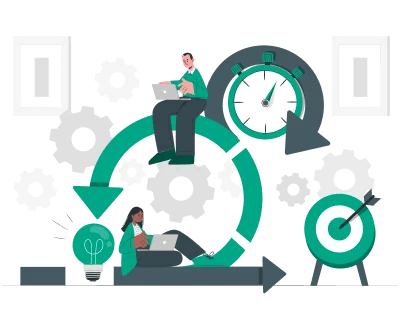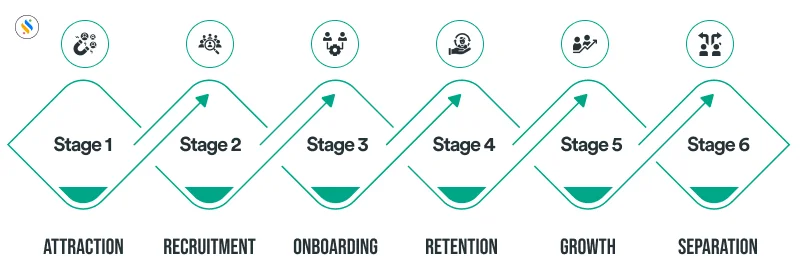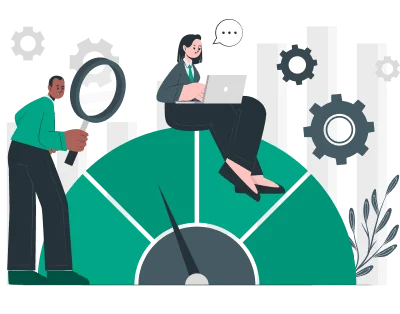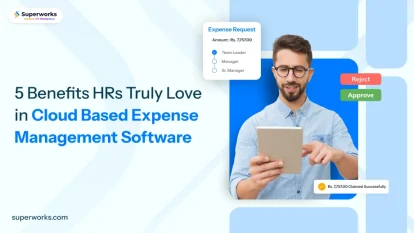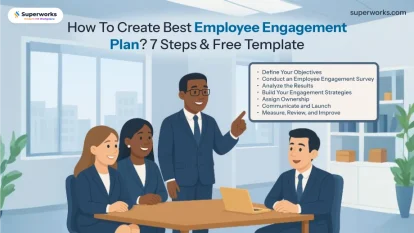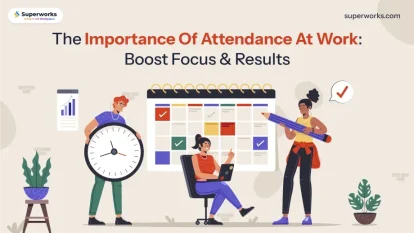Grab a chance to avail 6 Months of Performance Module for FREE
Book a free demo session & learn more about it!
-
Will customized solution for your needs
-
Empowering users with user-friendly features
-
Driving success across diverse industries, everywhere.
Grab a chance to avail 6 Months of Performance Module for FREE
Book a free demo session & learn more about it!
Superworks
Modern HR Workplace
Your Partner in the entire Employee Life Cycle
From recruitment to retirement manage every stage of employee lifecycle with ease.



Seamless onboarding & offboarding
Automated compliance & payroll
Track performance & engagement
Elevate Strategies For Successful Employee Lifecycle Management With HRMS
- Superworks
- 6 min read
- December 1, 2023
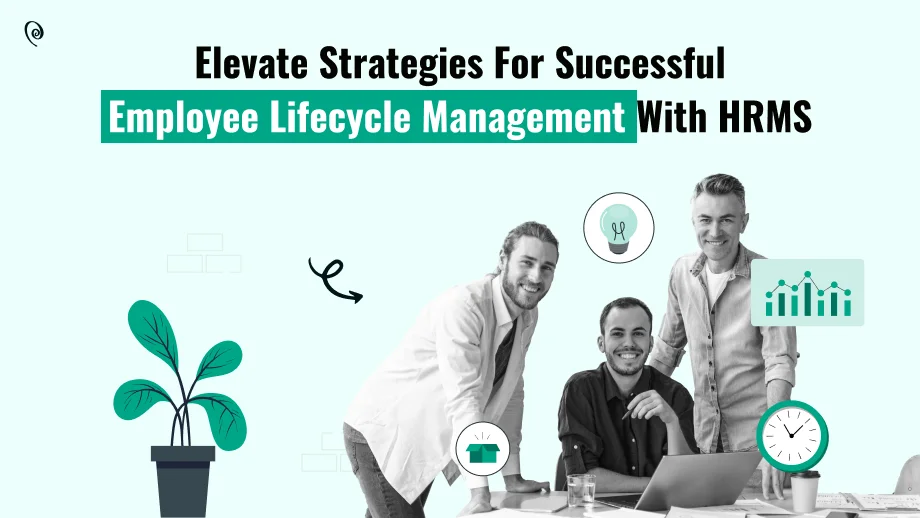
Employee Lifecycle Management (ELM) is an integral component of Human Resource (HRM) that holds the potential to transform how organizations engage, retain, and empower their workforce. It revolves around the concept of orchestrating the entire journey an employee undergoes while affiliated with an organization.
By astutely managing the stages of this journey, companies can not only bolster employee engagement but also enhance retention rates, ultimately contributing to heightened productivity. In this comprehensive guide, we will delve deep into the concept of Employee Lifecycle Management, explore the critical stages of the Employee Lifecycle Model, and discuss the pivotal role of HRMS Software. Special attention will be given to Superworks Indian HRMS Software, a leading solution in the realm of HR Management particularly in the context of India.
What is Employee Lifecycle Management?
Employee Lifecycle Management (ELM) serves as a strategic framework adopted by organizations to govern and enrich the interactions between employees and their employing company. At its core, ELM encompasses six distinct yet interrelated stages, each playing a pivotal role in shaping an employee’s journey within an organization.
To read more: How Employee Engagement Survey Tools Work?
What Are The Stages Of The Employee Lifecycle Model?
The Employee Lifecycle Model is delineated into six fundamental stages, elucidating the evolution of an employee’s association with the organization:
Attraction:
This phase marks the initial contact of potential candidates with the company’s employee engagement strategies. HR professionals employ various techniques and approaches to attract and captivate top-tier talent.
Recruitment:
As the name suggests, this stage embodies the transition where a prospective candidate transforms into a newly recruited employee, marked by a formal recruitment Process.
Onboarding:
HR managers wield significant influence during this phase by assisting new employee HR onboarding and acclimatizing to the organizational culture and integrating seamlessly into their roles.
Retention:
Once integrated into the organizational fabric, HR managers are tasked with engaging and satisfying employees through targeted job enrichment initiatives.
Growth:
In this phase, hr core professionals and managers collaborate on multifaceted efforts to support employees in enhancing their roles and reaching their full potential.
Separation:
The final stage is characterized by an employee’s decision to part ways with the organization. During this phase, HR professionals ensure a seamless offboarding experience, including the completion of requisite documentation.
Read more: What Are The Hidden Benefits Of Salary Software? Decoded In 10 Different Ways!

Elevate your workforce with Employee Lifecycle Management.
Transform your workforce management with our comprehensive Employee Lifecycle Management solution.
Revolutionize your workforce management – contact us for Employee Lifecycle Excellence!
Why is Employee Lifecycle Management Important?
Employee Lifecycle Management assumes paramount significance for a multitude of reasons. Foremost, it compels organizations to meticulously evaluate and enhance the employee experience at every stage. A contented employee is more inclined to remain with the company, leading to enhanced retention rates and diminished turnover costs. Additionally, organizations are encouraged to invest in learning and development initiatives, propelling employees toward their full potential.
The Role of HRMS Software in Employee Lifecycle Management

The advent of HRMS Software India, exemplified by solutions like Superworks has ushered in a transformative era in Employee Management. The implementation of HRMS Software confers several significant advantages, including:
Smoothing Employee HR Onboarding:
By automating and streamlining the onboarding process and Indian HRMS Software ensures that new employees swiftly assimilate into the organizational ecosystem.
Facilitating Timely Offboarding:
It plays a pivotal role in ensuring that the offboarding process is meticulously organized, encompassing all necessary documentation and procedures.
Saving Money and Resources:
By minimizing manual operations and optimizing workflow efficiency, HRMS Software delivers cost savings and resource optimization. We are providing workflow systems software for manage employee project.
Simplifying Data Management:
HR Software centralizes data storage and retrieval, simplifying the arduous task of managing employee information.
Enhancing Overall Employee Experience:
By providing a cohesive and user-friendly interface for employees such as an employee self-service portal. HR Software contributes to an enriched overall employee experience, resulting in higher job satisfaction.
Eliminating Manual Operations:
Repetitive manual tasks are minimized, freeing up HR professionals to focus on strategic initiatives that truly impact the organization.
Improving Compliance:
A HRMS Software for small business assists in ensuring that the organization complies with relevant labor laws and regulations, mitigating legal risks.
Also, See: Buyer’s Guide: Top 5 HCM Solution Software Of 2024
How to Measure & Improve the Employee Lifecycle Journey?
Measuring and enhancing the employee lifecycle journey is imperative for organizations striving to attract and retain top talent. This entails:
Analyzing Employee Data:
Employing data analytics to glean actionable insights into each stage of the employee lifecycle, enabling data-driven decision-making.
Creating a Systematic Approach:
Providing employees with a structured and consistent framework to navigate during their tenure with the organization, enhancing clarity and alignment.
Employee Surveys and Feedback:
Conduct regular surveys to gather feedback at different stages of the employee lifecycle, such as onboarding, performance reviews, and exits.
Use anonymous surveys to encourage honest responses and identify areas for improvement.
Onboarding Effectiveness:
Evaluate the onboarding process to ensure a smooth transition for new hires. Measure the time it takes for employees to become fully productive in their roles.
Gather feedback from new hires to identify any challenges faced during HR onboarding and implement improvements based on their input.
Employee Development and Training:
Track employees’ participation in training programs and professional development opportunities. Measure the impact of training initiatives on skill development and job performance.
Ensure that employees have access to ongoing learning resources to enhance their capabilities and contribute to their career growth within the organization.
By consistently measuring these aspects of the employee lifecycle journey and implementing improvements based on the findings, organizations can create a more supportive and engaging workplace, leading to increased employee satisfaction and productivity.
Also, See: 10 Must Have Human Resource Policies For Any Organization
Conclusion
In conclusion, the Employee Life cycle Model stands as an indispensable strategic HRM framework that empowers organizations to anticipate, optimize, and elevate every facet of an employee’s interactions within the company. It equips employees with the knowledge and resources needed to maximize the profitability of each phase of their career with the organization.
Armed with this profound understanding of Employee Lifecycle Management, organizations have the tools- Superworks – at their disposal to not only attract and retain exceptional talent but also to perpetuate their journey towards sustained success. The transformative power of ELM awaits, ready to reshape your workforce and business trajectory. Seize the opportunity to unlock its full potential and embark on a journey of organizational excellence.
